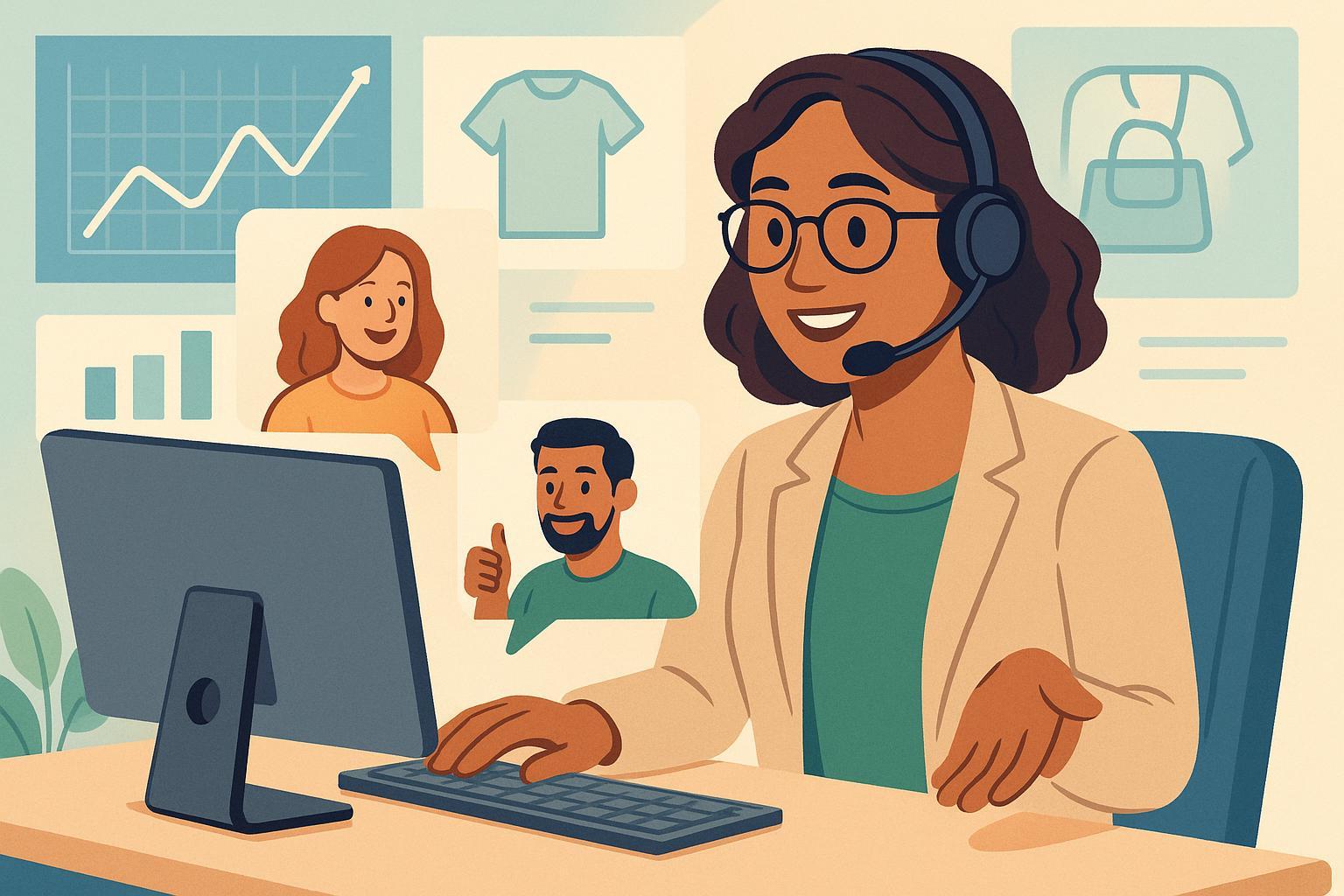The Role of a Customer Retention Representative: Key Skills and Responsibilities

Introduction: Why Customer Retention Is Your Best Career Move
Have you ever wondered who’s behind those quick responses, tailored offers, or genuine apologies when things go wrong with your favorite online store? That’s the Customer Retention Representative—a crucial role in today’s e-commerce and service-driven businesses. In fact, did you know that retaining an existing customer can be up to five times more cost-effective than acquiring a new one? (Harvard Business Review)
With brands like Zappos and Bombas setting gold standards for loyalty, retention reps are no longer just support agents—they’re relationship-builders, problem-solvers, and data-powered strategists. Whether you’re starting your first job or pivoting into a digital-first field, this guide will show you:
- What customer retention truly means
- What a retention rep does every day
- The skills you’ll need (and how to build them)
- Real-world scenarios and learning pathways
- How best-in-class tools like Attribuly make work smarter (and more satisfying)
Let’s break it all down step by step—no jargon, just the essentials!
Section I: Customer Retention 101
What Is Customer Retention?
Customer retention is about keeping existing customers satisfied, loyal, and continually engaged—reducing the risk they’ll take their business elsewhere. In simple terms, it’s the difference between a brand people remember vs. one they forget.
Key Terms Explained
- Churn: When a customer stops buying or cancels a subscription.
- Retention Rate: The percentage of customers who stay with your company over time.
- Lifetime Value (LTV): The total revenue a customer brings to a business throughout their relationship.
- Segmentation: Grouping customers by shared traits (like purchase history, behavior, or preferences) to address their needs better.
- Attribution: Figuring out which actions, campaigns, or channels are most responsible for keeping customers engaged.
Why Is Retention More Powerful Than Acquisition?
- Costs less. Marketing to loyal customers is cheaper than winning new ones.
- Boosts revenue. Repeat customers tend to spend more over time.
- Improves products. Loyal customers provide honest feedback that businesses use to improve.
For e-commerce especially, strong retention means predictable sales, enthusiastic word-of-mouth, and a real edge in crowded markets.
Section II: The Customer Retention Rep Role—Your Impact & Typical Day
Job Definition & Placement
As a Customer Retention Representative, you work at the intersection of customer support, marketing, and data analytics. You’re the one helping shoppers feel valued after their first purchase, handling concerns with empathy, and turning feedback into future loyalty.
Typical Teams: You’ll most often find this role in e-commerce brands (like Shopify merchants), subscription businesses, SaaS platforms, and any company focused on long-term customer relationships.
A Day in the Life
- Morning: Review retention metrics. Check for at-risk customers flagged by analytics (e.g., Attribuly’s dashboard).
- Midday: Respond to emails/chats—renewal reminders, address complaints, personalize offers.
- Afternoon: Analyze feedback, trigger segmented campaigns, cross-team update on retention KPIs.
- Finish: Document customer outcomes, plan next actions, review retention playbook.
Pro tip: Efficient reps keep a workflow checklist and learn from the best—Zappos’ “personal approach” and Dollar Shave Club’s proactive support are industry favorites!
Section III: Core Responsibilities—Step by Step
| Responsibility | What You’ll Actually Do | Tools/Practice |
|---|---|---|
| Renewals & Loyalty | Send reminders, offer incentives | Email, SMS, CRM/broadcast (Attribuly) |
| Conflict Management | Respond to complaints, resolve issues | Empathetic scripts, CRM (Attribuly) |
| Upselling / Win-Back | Personalized outreach to dormant customers, present relevant upgrades | Segmentation, campaign tools (Attribuly) |
| KPI Monitoring | Track retention rate, churn, LTV | Dashboard analytics (Attribuly) |
| Customer Feedback Relay | Gather feedback, escalate improvements | Surveys, feedback analytics |
| Documentation & Reporting | Record outcomes, plan workflow steps | Excel, Google Sheets, CRM/Attribuly exports |
Practical Workflow Example
- Log into your analytics dashboard (Attribuly, HubSpot, etc.).
- Review flagged accounts: Who hasn’t ordered recently, who’s submitted negative feedback?
- Send segmented email/SMS campaigns (win-back, renewal, loyalty rewards).
- Handle incoming support requests. Use scripts for empathy and quick solution-finding.
- Report on KPIs: Update your manager/team on success and improvement areas.
Section IV: Key Skills (and How to Build Them)
1. Communication
- Listen actively, respond clearly, keep a positive tone—even when customers are upset.
- Practice: Roleplay tough scenarios (see practice lab below).
2. Empathy
- Understand the customer’s frustration, validate emotions, avoid generic responses.
- Practice: Sample scripts; real-time feedback (team or manager review).
3. Analytical Thinking
- Spot negative trends (rising churn); interpret customer feedback; identify retention triggers.
- Practice: Interpreting Attribuly dashboards.
4. Problem-Solving
- Quickly propose solutions, use available tools, know when to escalate.
- Practice: Checklist-based decision guides. Team learning from past cases.
5. Tool Proficiency (CRM, Analytics)
- Be comfortable using platforms like Attribuly, HubSpot, Zendesk for workflows, segmentation, and reporting.
- Practice: Guided tool walkthrough video or interactive demo; build a sample dashboard.
Self-Assessment Checklist (Print or Save!)
- [ ] I know key retention terms (churn, LTV, segmentation).
- [ ] I can handle a tough customer request empathetically.
- [ ] I can use a CRM or analytics dashboard to review KPIs.
- [ ] I roleplay scenarios each week to improve my responses.
- [ ] I seek feedback after tough cases and adjust my approach.
Section V: Tools & Workflows—Modern Retention Stack
What Tools Power Retention Success?
- CRM Platforms: Organize customer data and manage communications (Zendesk, HubSpot, Salesforce).
- Analytics/Attribution Tools: See which actions/campaigns improve retention (Attribuly, Mixpanel, Segment).
- Campaign Automation: Trigger outreach campaigns based on customer behavior and segments (Customer.io, Klaviyo).
- AI-Powered Assistants: Guide reps in real time or automate routine responses.
Using Attribuly in Practice
Attribuly is a powerful retention companion for e-commerce brands:
- Multi-touch attribution shows how various emails, ads, or offers combine to boost retention.
- Segmentation and targeting automatically identify at-risk or high-value customers for renewal, cross-sell, or loyalty campaigns.
- Automated triggered campaigns let reps reach out at exactly the right time—no technical background required.
- Real-time dashboards reveal which retention tactics truly move the needle.
Try Attribuly for actionable customer journey mapping and improved retention results
Practical Video/Guide Resources
Section VI: Practice Lab—Real Scenarios & Skill Drills
Scenario 1: Handling a Renewal Objection
Customer: "I’m not sure your service is worth it anymore." You: (Empathy first!) "I really appreciate your honesty. Can you share what's changed for you recently?"
- Validate the concern, listen, offer a custom solution (discount, feature), and track the outcome via Attribuly.
Scenario 2: Win-Back for Dormant Customers
- Review segment in Attribuly.
- Send personalized re-engagement email with a warm message and tailored offer.
Scenario 3: Upselling with Data
- Spot high-engagement segment using analytics.
- Recommend new feature/product in your outreach, referencing real benefits.
Mini-Exercises
- Roleplay with a team member or coach—swap best practice scripts.
- Analyze a sample retention dashboard (Attribuly): What would you do next?
- Build your own email template for a loyalty campaign.
Section VII: Learning Path & Career Growth
Your Stepwise Roadmap
- Phase 1: Master retention vocabulary & key concepts (Quiz: Churn, LTV, Segmentation).
- Phase 2: Practice core workflows—handle real scenarios, document learnings.
- Phase 3: Use and compare retention tools (Attribuly demo, CRM onboarding).
- Phase 4: Self-assessment, feedback, improvement—track KPIs and show your results.
- Phase 5: Map your career path—Rep → Senior Rep → Retention Manager → Cross-functional roles.
Key Milestones
- Confidently explain retention and core KPIs to a friend or manager.
- Successfully manage your first challenging retention call.
- Build and review your own retention dashboard.
- Draft a personal development plan and seek out mentoring opportunities.
Salary Outlook & Demand
- Entry-level reps: $35,000–$55,000/year (Zippia).
- Managers: $70,000–$120,000+, especially in high-growth industries like SaaS, e-commerce.
Conclusion: Top Takeaways & Next Steps
- Retention is where relationships drive results—your work matters more than you think!
- Success comes from mastering communication, empathy, and using analytics smartly.
- The right tools, like Attribuly, help you focus your energy on what really improves customer loyalty and lifetime value.
Ready to build your next steps? Practice the scenarios, refresh your dashboard skills, and explore live support communities and Attribuly’s resources. This field values curiosity, growth, and helping others—if that’s you, you’re in the right place!
Frequently Asked Questions (FAQs)
Q: Do I need an advanced degree to become a retention rep?
A: No! Most entry jobs require high school or associate’s degree, strong communication skills, and willingness to learn analytic tools.
Q: What if I make a mistake or upset a customer?
A: Mistakes happen. Apologize honestly, listen, and seek feedback to improve. Use recovery scripts and keep learning (see practice lab).
Q: Is e-commerce different from SaaS or telecom retention work?
A: While the basics are the same (protect relationships!), specific workflows and KPIs may shift. E-commerce uses tools like Attribuly to unify data across platforms for quick action.
Q: Can I try retention tools as a beginner?
A: Absolutely! Many platforms (including Attribuly) offer demos, free trials, or interactive guides. Starting early helps!
Q: Where can I find more learning resources?
A: Check the Userpilot blog, Zendesk Resource Library, and Attribuly’s blog & support.
Quick Reference & Templates
You’ve got this! Every expert started with one conversation, one dashboard, and one authentic relationship. Welcome to a career where your empathy and insight truly make a difference.
